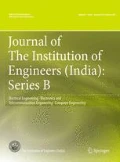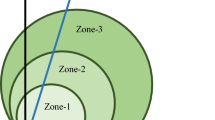Abstract
The intermediate connection between load and generation unit is cost-effective as it does not require an extra substation and associated equipment. Renewable energy sources are the best choice for employing an intermediate connection to load and generation units. The design of such three-terminal transmission line having an infeed current behind the tap point demanded careful settings of the relay. In this work, the distance protection scheme on the 132 kV transmission line is investigated to consider the effect of infeed current from renewable energy sources. In the research, it found that the traditional three-step distance protection settings encountered serious issues of under-reach. The proposed method provides primary protection and backup protection to a multi-terminal transmission line without tap information. Pre-calculated data using PMU such as infeed current, the compensated constant, and positive, negative, and zero sequence components of electrical quantity are used by the local distance relay. The simulation results on the three-terminal line system and modified IEEE 9 bus system show that the algorithm is faster, more accurate, more cost-effective, and more reliable than the existing zones of the protection method.










Similar content being viewed by others
References
B.K.R. Bhalja, AI-Based Scheme for the Protection of Multi-Terminal Transmission Lines (CRC Press, 2021), pp.197–220. https://doi.org/10.1201/9780367552374-8
J. Pinto De Sa, J. Afonso, R. Rodrigues, A probabilistic approach to setting distance relays in transmission networks. IEEE Trans. Power Deliv. 12(2), 681–686 (1997). https://doi.org/10.1109/61.584342
J. Pinto De Sa, J. Afonso, R. Rodrigues, A probabilistic approach to setting distance relays in transmission networks. IEEE Trans. Power Deliv. 12(2), 681–686 (1997). https://doi.org/10.1109/61.584342
S. Raman, R. Gokaraju, A. Jain, An adaptive fuzzy MHO relay for phase backup protection with infeed from STATCOM. IEEE Trans. Power Deliv. 28(1), 120–128 (2013). https://doi.org/10.1109/TPWRD.2012.2226062
S.H. Horowitz, A.G. Phadke, Third zone revisited. IEEE Trans. Power Deliv. 21(1), 23–29 (2006)
P. Regulski, W. Rebizant, M. Kereit, S. Schneider, Adaptive reach of the 3rd zone of a distance relay with synchronized measurements. IEEE Trans. Power Deliv. 36(1), 135–144 (2021). https://doi.org/10.1109/TPWRD.2020.2974587
V. Telukunta, J. Pradhan, A. Agrawal, M. Singh, S.G. Srivani, Protection challenges under bulk penetration of renewable energy resources in power systems: a review. CSEE J. Power Energy Syst. 3(4), 365–379 (2017). https://doi.org/10.17775/CSEEJPES.2017.00030
Y. Fang, K. Jia, Z. Zhu, T. Feng, Z. Yang, B. Liu, Adaptability analysis of distance protection on the transmission lines emanating from renewable power generators. IEEE Innov. Smart Grid Technol. Asia (2019). https://doi.org/10.1109/ISGT-Asia.2019.8881096
B.A. Oza, Power System Protection and Switchgear (Tata McGraw-Hill Education, 2010)
Y.G. Paithankar, S.R. Bhide, Fundamentals of Power System Protection (PHI Learning Pvt. Ltd., 2011)
G. Ren, J. Liu, J. Wan, Y. Guo, D. Yu, Overview of wind power intermittency: impacts, measurements, and mitigation solutions. Appl. Energy 204, 47–65 (2017). https://doi.org/10.1016/j.apenergy.2017.06.098
N. Nimpitiwan, G.T. Heydt, R. Ayyanar, S. Suryanarayanan, Fault current contribution from synchronous machine and inverter based distributed generators. IEEE Trans. Power Deliv. 22(1), 634–641 (2007). https://doi.org/10.1109/TPWRD.2006.881440
H. Hooshyar, M.E. Baran, Fault analysis on distribution feeders with high penetration of PV systems. IEEE Trans. Power Syst. 28(3), 2890–2896 (2013). https://doi.org/10.1109/TPWRS.2012.2227842
J. Morren, S.W.H. de Haan, Short-circuit current of wind turbines with doubly fed induction generator. IEEE Trans. Energy Convers. 22(1), 174–180 (2007). https://doi.org/10.1109/TEC.2006.889615
T. Bi, W. Li, Z. Xu, Q. Yang, First-zone distance relaying algorithm of parallel transmission lines for cross-country grounded faults. IEEE Trans. Power Deliv. 27(4), 2185–2192 (2012)
J.P. Desai, V.H. Makwana, Phasor measurement unit incorporated adaptive out-of-step protection of synchronous generator. J. Mod. Power Syst. Clean Energy (2020). https://doi.org/10.35833/MPCE.2020.000277
M.M. Eissa, M.E. Masoud, M.M.M. Elanwar, A novel back-up wide area protection technique for power transmission grids using phasor measurement unit. IEEE Trans. Power Deliv. 25(1), 270–278 (2010). https://doi.org/10.1109/TPWRD.2009.2035394
P.V. Navalkar, S.A. Soman, Secure remote backup protection of transmission lines using synchrophasors. IEEE Trans. Power Deliv. 26(1), 87–96 (2011). https://doi.org/10.1109/TPWRD.2010.2076350
A. Iamandi, I. Ionescu, M. Dragomir, S.S. Iliescu, A. Dragomir, Reliability of protection schemes used for multi-terminal transmission lines, in 2019 8th International Conference on Modern Power Systems (MPS) (2019), pp. 1–5. https://doi.org/10.1109/MPS.2019.8759763
J. Desai, V. Makwana, Power swing blocking algorithm based on real and reactive power transient stability. Electric Power Comp. Syst. 48(16–17), 1673–1683 (2020). https://doi.org/10.1080/15325008.2021.1906794
B. Rathore, A.G. Shaik, Fault analysis using alienation technique for three-terminal transmission line, in 2018 2nd International Conference on Power, Energy and Environment: Towards Smart Technology (ICEPE) (2018), pp. 1–6. https://doi.org/10.1109/EPETSG.2018.8658370
N.A. Al-Emadi, A. Ghorbani, H. Mehrjerdi, Synchrophasor-based backup distance protection of multi-terminal transmission lines. IET Gener. Transm. Amp Distrib. 10(13), 3304–3313 (2016)
A. Rahmati, R. Adhami, A fault detection and classification technique based on sequential components. IEEE Trans. Ind. Appl. 50(6), 4202–4209 (2014). https://doi.org/10.1109/TIA.2014.2313652
Funding
Not applicable.
Author information
Authors and Affiliations
Corresponding author
Ethics declarations
Competing interests
The author declares that they have no competing interests
Additional information
Publisher's Note
Springer Nature remains neutral with regard to jurisdictional claims in published maps and institutional affiliations.
Rights and permissions
Springer Nature or its licensor holds exclusive rights to this article under a publishing agreement with the author(s) or other rightsholder(s); author self-archiving of the accepted manuscript version of this article is solely governed by the terms of such publishing agreement and applicable law.
About this article
Cite this article
Desai, J.P. Three-Terminal Transmission Line Protection By Considering Effect of Infeed Current. J. Inst. Eng. India Ser. B 103, 2165–2175 (2022). https://doi.org/10.1007/s40031-022-00795-7
Received:
Accepted:
Published:
Issue Date:
DOI: https://doi.org/10.1007/s40031-022-00795-7




